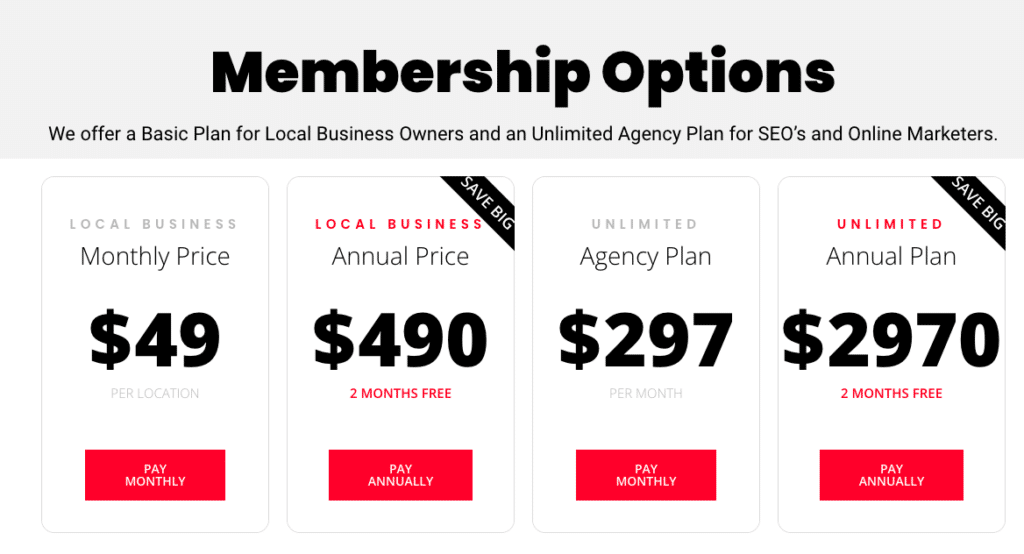Different Ways to Optimize Local Business Listings

Local business listings play a crucial role in the success of small businesses. When potential customers search for products or services in their local area, having an optimized local business listing can significantly increase visibility and attract more customers. In this article, we will explore various strategies and techniques to optimize local business listings and maximize their impact.
1. Claim and Verify Your Business Listing
The first step in optimizing your local business listing is to claim and verify it on popular search engines and directories such as Google My Business, Bing Places, and Yelp. This process involves providing accurate and up-to-date information about your business, including its name, address, phone number, website, and operating hours.
Claiming and verifying your business listing not only ensures that the information displayed is correct but also allows you to manage and respond to customer reviews, update business details, and add photos or videos. It is essential to regularly monitor and maintain your business listing to keep it optimized and relevant.
Get your FREE 14 DAY TRIAL for over 300 local citations. Click below!

2. Optimize Business Description and Categories
When optimizing your local business listing, pay close attention to the business description and categories. The business description should be concise, engaging, and keyword-rich. It should accurately reflect your business’s products, services, and unique selling points.
Additionally, selecting the most relevant categories for your business is crucial. Choose categories that accurately represent your business and align with the search intent of potential customers. For example, if you own a bakery, selecting categories such as “Bakery,” “Cakes,” and “Pastries” would be appropriate.
3. Use High-Quality Images and Videos
Visual content plays a significant role in attracting and engaging potential customers. When optimizing your local business listing, include high-quality images and videos that showcase your products, services, and the overall ambiance of your business.
For example, if you own a restaurant, include images of your delicious dishes, the cozy interior, and happy customers enjoying their meals. Similarly, if you own a salon, include images of stylish haircuts, trendy nail art, and a relaxing atmosphere.
4. Encourage and Respond to Customer Reviews
Customer reviews have a significant impact on the reputation and credibility of your business. Positive reviews can attract more customers, while negative reviews can deter potential customers. Therefore, it is crucial to encourage satisfied customers to leave reviews and promptly respond to both positive and negative feedback.
When responding to reviews, thank customers for their positive feedback and address any concerns or issues raised in negative reviews. This shows potential customers that you value their feedback and are committed to providing excellent customer service.
5. Optimize for Local Keywords
Optimizing your local business listing for relevant keywords is essential for improving its visibility in local search results. Conduct keyword research to identify the most commonly used search terms related to your business and incorporate them naturally into your business description, categories, and other relevant fields.
For example, if you own a pet grooming salon in New York City, incorporating keywords such as “pet grooming NYC,” “dog grooming salon,” and “cat grooming services” can help your business listing appear higher in local search results when potential customers search for these terms.
6. Ensure Consistency Across Online Directories
Consistency is key when it comes to optimizing local business listings. Ensure that your business name, address, phone number, and other details are consistent across all online directories and platforms where your business is listed.
Inconsistent information can confuse search engines and potential customers, leading to a negative impact on your business’s visibility and credibility. Regularly audit and update your business information to maintain consistency across all platforms.
7. Leverage Online Reviews and Testimonials
Online reviews and testimonials are powerful social proofs that can influence potential customers’ decision-making process. Incorporate positive reviews and testimonials from satisfied customers into your local business listing to build trust and credibility.
For example, if you own a fitness studio, include testimonials from clients who have achieved their fitness goals or experienced positive changes in their lives through your services. This can inspire potential customers to choose your business over competitors.
8. Optimize for Voice Search
Voice search is becoming increasingly popular, with more people using voice assistants like Siri, Alexa, and Google Assistant to find local businesses. To optimize your local business listing for voice search, focus on long-tail keywords and natural language phrases that people are likely to use when speaking.
For example, instead of optimizing for “best pizza restaurant,” optimize for “where can I find the best pizza restaurant near me.” This approach aligns with how people typically phrase their voice search queries and increases the chances of your business appearing in voice search results.
9. Utilize Online Directories and Citation Services
Online directories and citation services can significantly boost the visibility of your local business listing. These platforms allow you to create consistent and accurate business listings across multiple directories, saving you time and effort.
Citation Vault is an excellent example of a local citation service that automates the process of creating 300 local citations for any business. By utilizing such services, you can ensure that your business is listed in popular directories, increasing its visibility and reach.
Summary
Optimizing local business listings is crucial for small businesses to attract more customers and increase their visibility in local search results. By claiming and verifying your business listing, optimizing the description and categories, using high-quality images and videos, encouraging and responding to customer reviews, optimizing for local keywords, ensuring consistency across online directories, leveraging online reviews and testimonials, optimizing for voice search, and utilizing online directories and citation services, you can maximize the impact of your local business listing and drive more customers to your business.
Remember, consistency, relevance, and engagement are key when it comes to optimizing local business listings. By implementing these strategies and techniques, you can position your business for success in the competitive local market.
So, take the necessary steps today to optimize your local business listing and watch your business thrive!
This article mentions Citation Vault, a local citation service that automates 300 local citations for any business.
Frequently Asked Questions

What Are Some Different Ways to Optimize Local Business Listings?
Optimizing your local business listings is crucial for improving your online visibility and attracting more local customers. There are several effective ways to optimize your listings:
Complete and Verify Your Listings: Start by claiming and verifying your business listings on popular platforms like Google My Business, Bing Places, Yelp, and Facebook. This establishes your ownership and control over the listings.
Accurate NAP Information: Ensure that your business’s Name, Address, and Phone number (NAP) are consistent and accurate across all online platforms, including your website. Inconsistent NAP information can confuse search engines and customers.
Choose Relevant Categories: Select categories and attributes that accurately describe your business. This helps search engines categorize your business correctly and connect you with relevant local searches.
High-Quality Visual Content: Include high-resolution images and videos that showcase your products, services, and the overall ambiance of your business. Visual content makes your listing more appealing to potential customers.
Keyword Optimization: Incorporate relevant keywords into your business description and listing content. Use location-specific keywords that reflect the areas you serve to improve your listing’s visibility in local search results.
Business Hours: Ensure that your business hours are up to date, including any variations for holidays or special occasions. Accurate hours help customers plan their visits and reduce frustration.
Customer Reviews: Actively encourage satisfied customers to leave reviews on your listings. Positive reviews can enhance your online reputation and influence potential customers.
Additional Features: Take advantage of any additional features offered by the platform, such as posts, Q&A sections, appointment scheduling, and menu items. These features can engage users and enhance your listing’s functionality.
Monitor and Respond to Reviews: Regularly monitor customer reviews and respond to them promptly and professionally, whether they are positive or negative. Engaging with customers through reviews can build trust and improve your online reputation.
Local SEO Optimization: Implement local SEO strategies within your listings. This includes optimizing for voice search, using schema markup, and building high-quality backlinks to your listings.
Analyze Performance: Utilize analytics tools provided by the platform to monitor your listings’ performance. Analyze metrics like views, clicks, user behavior, and interactions to assess effectiveness.
Stay Compliant: Familiarize yourself with the platform’s guidelines and policies to ensure your listings remain compliant. Violations can result in penalties or removal from the platform.
Consistent Branding: Maintain consistent branding elements, such as logos, colors, and messaging, across all listings. This reinforces your brand identity and helps customers recognize your business.
Engage with Users: Actively engage with users through features like posts, responses to questions, and appointment scheduling. Active engagement can enhance the user experience and drive customer interactions.
By implementing these optimization strategies and regularly updating your local business listings, you can maximize their effectiveness in attracting local customers and improving your online presence. Optimization is an ongoing process that requires attention and maintenance to yield the best results.
How Can I Optimize My Local Business Listings for Voice Search?
Optimizing your local business listings for voice search is becoming increasingly important as more consumers use voice-activated devices and virtual assistants. Here’s how to do it effectively:
Use Natural Language Keywords: When optimizing your business description and content, use natural language keywords and phrases that people are likely to use in voice search queries. Think about how customers might verbally ask for services or products in a conversational tone.
Include Location-Specific Phrases: Incorporate location-specific keywords into your listing content. This helps your business appear in voice search results for local queries. For example, include phrases like “near me” or “in [city name].”
Create an FAQ Section: Add an FAQ section to your listing that addresses common questions customers might ask in voice search. Provide concise and informative answers in a conversational style.
Optimize for Featured Snippets: Aim to appear in featured snippets, also known as “Position 0” in search results. Voice assistants often pull information from featured snippets to answer voice queries. Structure your content to provide direct and concise answers to common questions.
Mobile Optimization: Ensure that your website is mobile-friendly and loads quickly. Many voice searches occur on mobile devices, so a responsive design is essential.
Use Structured Data Markup: Implement structured data markup, such as schema.org markup, to provide search engines with additional information about your business. This can enhance your chances of appearing in voice search results.
Claim and Optimize Google My Business: Google My Business listings are prominently featured in voice search results. Claim and optimize your GMB listing with accurate information, including business hours and location.
Optimize for “Near Me” Searches: As “near me” searches are common in voice queries, make sure your listing is well-optimized for these local searches. Include phrases like “best [product or service] near me” in your content.
Consistency Across Platforms: Maintain consistency in your business details, such as NAP information and categories, across all local listing platforms. Consistency builds trust with search engines.
Encourage Reviews: Positive reviews can enhance your local SEO and voice search visibility. Encourage satisfied customers to leave reviews mentioning their positive experiences.
Voice Search Phrasing: Research and understand how people phrase voice search queries related to your industry. Tailor your content to match these natural language patterns.
Voice Search Testing: Use voice-activated devices and virtual assistants to test how your business appears in voice search results. This firsthand experience can help you refine your optimization efforts.
By implementing these strategies, you can optimize your local business listings to better align with voice search trends, improving your chances of being featured in voice search results and attracting local customers using voice-activated devices.
- Different Ways to Optimize Local Business Listings
- local business listings
- local canadian citations
- local citations







